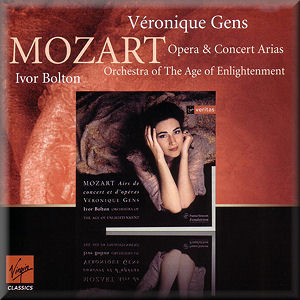 |
 |
|


alternatively
CD: MDT
|
Wolfgang Amadeus
MOZART (1756-1791)
Opera and Concert Arias
La clemenza di Tito (1791):
Deh, per questo istante solo [5:52]
Ecco il punto...Non più di fiori vaghe catene [8:28]
Cosi fan tutte (1790):
Ei parte…Per pietà, ben mio [8:34]
Temerari…Come scoglio [5:40]
Don Giovanni (1787):
Batti, batti, o bel Masetto [3:27]
In quali eccessi…Mi tradì [5:35]
Le nozze di Figaro (1786):
Non so più cosa son [2:34]
Porgi, amor [3:16]
Concert arias:
Ch’io mi scordi di te?...Non temer, amato bene, K505 (1786)
[9:43]
O temerario Arbace!...Per quel paterno amplesso, K79 [6:01]
 Véronique Gens (soprano)
Véronique Gens (soprano)
Orchestra of the Age of Enlightenment/Ivor Bolton
rec. February/March 1998, Abbey Road Studios, London
 VIRGIN CLASSICS 6286332 [59:29]
VIRGIN CLASSICS 6286332 [59:29] 
|
|
|
All collectors have, I think, recorded versions of favourite
works to which they remain faithful. When, as a schoolboy, I
first encountered Berlioz’ Les Nuits d’été
- surely one of the most beautiful of all musical works - sung
by Janet Baker and with Barbirolli on the podium, I was hooked.
I learned to appreciate Régine Crespin’s reading,
but Janet had already stolen my heart, and as far as I was concerned
there could never be any rival. Then, some time in 2004, I read
a review of a new performance by French soprano Véronique
Gens and was encouraged to add it to my collection. Now, though
I still revere the earlier performance, when I want to hear
the work it is most likely Véronique that I take down
from the shelves. Hers is quite a different voice from that
of Dame Janet, more brilliant, yet rich and creamy, and just
as beautiful on the ear. And of course she is totally at ease
in the French language, a severe challenge for all but francophone
singers.
Here she is six years or so earlier in a selection of Mozart
arias. One notes that the voice had mellowed somewhat in those
six years: this voice might not so easily have seduced me in
Berlioz. It is a real soprano voice, of course, but there is
no Queen of the Night here. On the contrary, one or two mezzo
roles - and notes - creep in. Thus her Cherubino (from The
Marriage of Figaro) is a passionate and even troubled adolescent,
his amorous preoccupations - at a fairly rapid tempo - more
tortured than breathlessly impetuous. From the same opera, her
Countess is womanly and desirable, touchingly looking back on
what once was.
How subtly she characterises the recitative preceding Donna
Elvira’s superb Act 2 aria from Don Giovanni, “Mi
tradi quell’ alma ingratia”, and how outstandingly
well supported she is by the superb Orchestra of the Age of
Enlightenment and Ivor Bolton. It is the first clarinet who
shines here, but time and again throughout this recital one
is struck by the remarkable quality of the solo wind playing,
without wanting to take anything away from the superbly stylish
unanimity of the strings. And Gens effortlessly negotiates the
runs and leaps, at one point encompassing a low D and top B
flat in successive bars, having chosen just the right tempo
for the music and for her voice. And who could resist her coquettish
seduction technique as Zerlina in the same opera (“Batti,
batti, o bel Masetto”)? Certainly not I. Her way with
the words “baciar, baciar” would be enough for me.
She is equally persuasive in the remaining arias from Cosi
fan tutte and La clemenza di Tito, and the programme
is completed by two concert arias, of which K505 was in composed
in 1786 for the English soprano Nancy Storace. This work features
an important piano part written for the composer himself to
play, taken on this disc by Melvyn Tan.
Recorded recitals of operatic arias tend to be quite popular,
allowing the listener to taste, as it were, the work, without
having to sit through the three hours or so necessary to swallow
the whole. Lovers of Mozart or Véronique Gens need not
hesitate before investing in this one: each of these arias will
bring a little joy and light into anybody’s life, one
after the other, and all at a laughably modest price. One experiences
the operas differently, of course, through extracts such as
these. In the theatre one is struck, usually without thinking
about it, by Mozart’s almost supernatural skill for characterisation
and dramatic pacing. In a succession of arias such as this,
it is the composer’s remarkable melodic gift that comes
to the fore. One gorgeous tune follows another.
The booklet contains an excellent essay by Adélaïde
de Place outlining the context and content of each of the arias
recorded, helpful given that texts are not provided. The recording
is fine.
William Hedley
|
|

